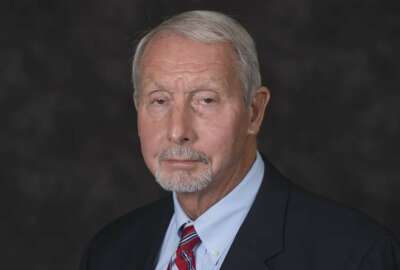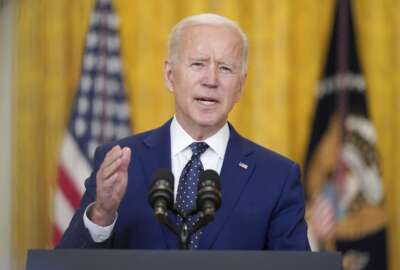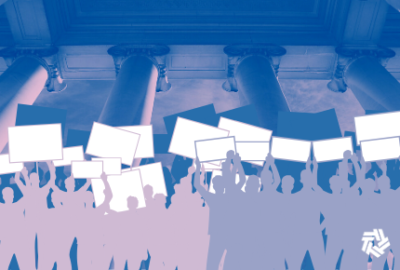
What is the best role for unions in the federal workplace?
For better or worse, public administration and the people who carry it out deal regularly with employee unions. But do unions help or hinder that public...
Best listening experience is on Chrome, Firefox or Safari. Subscribe to Federal Drive’s daily audio interviews on Apple Podcasts or PodcastOne.
For better or worse, public administration and the people who carry it out deal regularly with employee unions. Do unions help or hinder that public administration? In the first of a four-part series, Federal Unions: For better or for worse, distinguished professor emeritus at Indiana University James Perry gave his perspective to Federal Drive with Tom Temin, as someone who has studied this issue for 50 years.
Interview transcript:
Tom Temin: Jim, good to have you back.
James Perry: Thanks, Tom, good to be with you.
Tom Temin: And how would you summarize what you have learned in so many years of studying public administration and the role of unions in that whole complex?
James Perry: Well, my work with federal union’s goes back to the Civil Service Reform Act of 1978 when I was one of the primary evaluation contracts for OPM. And we did study labor management relations, although to be honest, we spent a lot more time on performance appraisal, merit pay, and other issues that were sort of the core of CSRA. And the labor relations part was essentially moving into law, what had been the executive order prior to that time. One of the things I’ve learned, I think, is that the quality of labor management relations depends fundamentally on the nature of the legal and regulatory process, that what I refer to as institutional arrangements. And I think, with respect to federal labor relations, I think we have a real problem. I believe that we are ultimately interested in trying to achieve collaboration between labor and management. But I don’t see the institutional arrangements, particularly the idea of dueling executive orders, when we move from democratic presidents, to republican presidents and back again, as functional for developing the quality of labor management relations that we would seek in a high functioning public service.
Tom Temin: Sure, in many ways, it’s like someone with one foot in boiling oil and the other foot on dry ice, and on average, they’re doing fine. But in fact, it’s really not a great situation.
James Perry: Right. But I do think that there’s a key role for unions in the federal workplace. And one of the interesting facts, I think, is that we have about five times more or a higher percentage of union members in the public sector than the private, which suggests that, among other things, that public officials and legislative entities are more receptive to unionization as a part of the workplace. But I think they do have a sort of a fundamental place in the federal workplace. And I think that’s important both for fairness, that is, I don’t like the idea of federal or other public employees being second class citizens because they work for a government entity. And so I think out of fairness, it’s important that employees have the right for collective action, and the opportunity to work with labor organizations. And then I really do think ultimately, they do improve the quality of what happens in the workplace, if the institutional arrangements are conducive to creating in the long run, high quality of collaboration between labor and management.
Tom Temin: And institutional arrangements, maybe define that a little bit more closely for us.
James Perry: Well, one is the law. And if we look, for instance, at the last two presidencies, we’ve had a shift from, for instance, the assumption of the legitimacy of labor organizations, to the rejection of the legitimacy of labor organizations and membership in unions. We saw attacks during the Trump administration on the very legitimacy of labor organizations and membership in them, which is, I think, a fundamental problem for anybody who’s seeking to develop effective strategies to coexist and to function effectively with collective organizations like labor unions.
Tom Temin: We’re speaking with Dr. Jim Perry, professor emeritus at Indiana University. Let me ask you this. At their very best, what can unions bring to the federal workplace and to the efficient operations of public administration, I think is how President Kennedy put it?
James Perry: Well, at their very best, I think they do several things. One is that they are great sources for what we would think of as preference aggregation. That is, rather than thinking in terms of individuals, we think about what is best for the sort of the collective interests of the members of an organization. So unions are great entities, being effectively democratic organizations for aggregating preferences. I think they’re also effective for holding management accountable. I think a great example of holding management accountable in the early part of this millennium, is the National Security Personnel System and Max-HR.
Tom Temin: Oh, remember that one? Yup.
James Perry: That is two new sets of policies that were brought to the Department of Defense in the Department of Homeland Security. And they were faulty in a variety of ways. And the union said, you need to get this right. If you’re not going to get this right we’re going to fight you tooth and nail, and that made good sense because they violated, among other things, what we know about good management and how to motivate employees in the public sector. And yet the administration was proceeding with that and the union said, no, you can’t do that. And so by representing the interests of their members and holding management accountable, they were able to undo, I think, some significant damage to government. Now, the other area, I think, where they can be very effective and supportive of the sort of the best interest of citizens is creating novel and innovative options for how the workplace is managed and organized. This is what maybe what we often refer to as collaboration. But I think some of the union positions and union activities related to telework, which we tried to avoid up until the pandemic, but then when the pandemic struck, we’ve discovered a telework is not as bad as people depicted it, the people on the management side or people running the organizations. And therefore, let’s take another look at it. And I think the unions were very effective for sort of bringing management to recognize the two sides of telework, the problem with monitoring employees, but on the other hand, the fact that telework creates a variety of options for employees that are attractive to employees. And ultimately, what labor management need to be thinking about is what I refer to and what’s been referred to since I was a graduate, well, well before I was a graduate student, as integrative solutions. We’ve come to know the integrative solutions now as win-win solutions. But unions can be helpful in moving management toward those win-win solutions, as opposed to the win-lose solutions that are so common to labor management relations. The problem is, again, going back to the institutional arrangements, I do not see the institutional arrangements, particularly in the federal sector as been conducive to moving both labor and management toward collaboration, toward integrative solutions, toward the win-win results we want to achieve…
Tom Temin: Sure.
James Perry: And the relationship between management and these collective entities.
Tom Temin: And are there situations when unions might be counterproductive? Are they always great friends like that?
James Perry: No. I see them becoming great friends and then the literature points this out. This is sort of an organic process. They start fighting one another tooth and nail, they move toward compromise, then they ultimately get to collaboration. So I think it’s important to look at that process of moving from denying the other party, to compromise, to win-win solutions as being a natural evolutionary process, and the question is, how do the institutional arrangements support that? The area where unions I think can be problematic is that they are representative entities, their political entities, and therefore, they cannot differentiate employee claims on their merits. That is the unions exist to represent the interests of their members, and therefore have to play their roles, perform their duties, regardless of the merit of a member’s claim. That’s something like a defense counsel, where you have to represent the rights of your client, regardless of their guilt or innocence. And that’s also true for unions. Now we see, I think, some extremes of that. For instance, the debates recently about rogue police officers, and police unions supporting rogue police officers, or incompetent teachers being supported by teacher unions. But I think that’s part of the functioning of the union, is one that we are interested in trying to find ways around or beyond and to find ways, for instance, where labor and management might be able to support high employee performance in ways that are responsive to each of their interests, and at the same time move forward in their collective relationship. But certainly this inability to differentiate employee claims on their merits, leads to lots of issues between labor and management. But I think it needs to be understood in those terms. That is, it’s like a defense counsel supporting the needs or interests of his or her client.
Tom Temin: In general, what are the best strategies for managers to negotiate and otherwise deal day-to-day with unions and unionized employees?
James Perry: Well, I already mentioned one, assumed the legitimacy of the other party. That was something that was denied repeatedly and the press is sort of filled with reports of this, denied repeatedly in the last administration. We need to find ways of assuring that if unions are going to exist in the federal sector, that they are perceived to be legitimate, regardless of who comes into the White House. The second thing is that the management needs to listen to and resolve conflicts where it’s appropriate to resolve conflicts. If management has somebody who is engaging in malfeasance or misfeasance, that’s in management’s interest to do something about that supervisor, do something about that work situation, so, conflicts need to be resolved when it’s appropriate to resolve those conflicts. And then the third item is one I’ve already touched on. And that is, we need to frame issues in integrative or win-win terms, not simply distributive or win-lose terms. And if we move toward, what’s been classically referred to as integrative bargaining, we’re gonna get some good results. And the unions are gonna be part of that, and management and citizens and the American electorate is going to be the winner, rather than the union or management. And so we need to think about how do we get to situations where we can develop more integrative relationships. And I’ve know of people like Bob Tobias, have written recently about the importance of collaboration. He and I are in agreement on that. And Bob is, I think, one of the great union leaders, not only in the federal sector, but globally. And he has insights about that, but we disagree about how we get there. We don’t get there simply by claiming that we need to collaborate, we have to get there organically as a part of an evolution of the relationship between labor and management under a suitable set of institutional arrangements, that is laws and regulations that get us to integrative solutions for the public.
Tom Temin: Dr. James Perry is professor emeritus at Indiana University. Thanks so much for joining me.
James Perry: Hey, thanks, Tom. Great to be with you.
Copyright © 2025 Federal News Network. All rights reserved. This website is not intended for users located within the European Economic Area.
Tom Temin is host of the Federal Drive and has been providing insight on federal technology and management issues for more than 30 years.
Follow @tteminWFED
Related Stories





